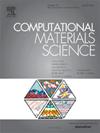多目标优化辅助三维定量卡恩-希利亚德模拟旋转分解过程中铁铬合金的微观结构演变
IF 3.1
3区 材料科学
Q2 MATERIALS SCIENCE, MULTIDISCIPLINARY
引用次数: 0
摘要
发生尖晶分解的相分离被认为是造成铁铬合金 "475 °C脆性 "的原因。因此,定量描述铁铬合金在尖晶分解过程中的微观结构演变至关重要。然而,对 Fe-Cr 合金旋光分解过程的原位或非原位定量实验观测通常很少,而且大多数数值模拟仍不能完全定量。本文系统地总结了有关铁铬合金中旋光性分解的 Cahn-Hilliard 模拟。我们采用帕累托最优驱动自动化框架,对 Fe-Cr 合金在旋光分解过程中的微结构演变进行了三维 Cahn-Hilliard 定量模拟。对新开发的探索策略和不同搜索算法的采样效率进行了广泛的研究和讨论。通过考虑多个特征微观结构数据,得出了 Cahn-Hilliard 模型的不确定材料/模型参数。模拟的多种微观结构特征与实验观测之间的显著一致性进一步验证了参数集的泛化能力。这表明该参数集可以定量模拟铁铬合金在各种条件下的微观结构演变,具有巨大的潜力。此外,帕累托最优驱动自动化框架在铁铬合金中的成功应用再次证实了其能力。本文章由计算机程序翻译,如有差异,请以英文原文为准。
Multi-objective optimization assisting three-dimensional quantitative Cahn-Hilliard simulations of microstructure evolution in Fe-Cr alloys during spinodal decomposition
Phase separation occurring spinodal decomposition is considered responsible for the “475 °C embrittlement” in Fe-Cr alloys. It is thus critical to gain quantitative descriptions of the microstructure evolution in Fe-Cr alloys during spinodal decomposition. However, quantitative in-situ or ex-situ experimental observations of spinodal decomposition processes in Fe-Cr alloys are generally scarce, and most numerical simulations are still not completely quantitative. In this paper, the Cahn-Hilliard simulations regarding spinodal decomposition in Fe-Cr alloys were systematically summarized. We employed the Pareto optimal driven automation framework to perform quantitative three-dimensional Cahn-Hilliard simulations of microstructure evolution in Fe-Cr alloys during spinodal decomposition process. The sampling efficiency of newly developed exploration strategies and different searching algorithms were extensively examined and discussed. The uncertain material/model parameters of the Cahn-Hilliard model were derived by considering multiple characteristic microstructure data. The remarkable consistency between the simulated multiple microstructure characteristics and the experimental observations further validated the generalization ability of the parameters set. It shows a massive potential that the parameters set can quantitatively simulate microstructure evolution in Fe-Cr alloys under various conditions. Furthermore, the capability of the Pareto optimal driven automation framework was reconfirmed by its successful application to Fe-Cr alloys.
求助全文
通过发布文献求助,成功后即可免费获取论文全文。
去求助
来源期刊

Computational Materials Science
工程技术-材料科学:综合
CiteScore
6.50
自引率
6.10%
发文量
665
审稿时长
26 days
期刊介绍:
The goal of Computational Materials Science is to report on results that provide new or unique insights into, or significantly expand our understanding of, the properties of materials or phenomena associated with their design, synthesis, processing, characterization, and utilization. To be relevant to the journal, the results should be applied or applicable to specific material systems that are discussed within the submission.
 求助内容:
求助内容: 应助结果提醒方式:
应助结果提醒方式:


